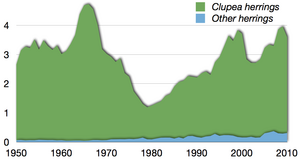
Back سمك مملح Arabic Sleď Czech شاهماهی Persian Hareng frais French Dawak GOM Haringe Croatian Bengkalis (ikan) ID ニシン Japanese Ikan hering Malay Śledź Polish
Herring are forage fish, mostly belonging to the family of Clupeidae.
Herring often move in large schools around fishing banks and near the coast, found particularly in shallow, temperate waters of the North Pacific and North Atlantic Oceans, including the Baltic Sea, as well as off the west coast of South America. Three species of Clupea (the type genus of the herring family Clupeidae) are recognised, and comprise about 90% of all herrings captured in fisheries. The most abundant of these species is the Atlantic herring, which comprises over half of all herring capture. Fish called herring are also found in the Arabian Sea, Indian Ocean, and Bay of Bengal.
Herring played an important role in the history of marine fisheries in Europe,[2] and early in the 20th century, their study was fundamental to the development of fisheries science.[3][4] These oily fish[5] also have a long history as an important food fish, and are often salted, smoked, or pickled.
Herring were also known as "silver darlings" in the United Kingdom.[6]
- ^ Based on data sourced from the relevant FAO Species Fact Sheets Archived 2009-05-08 at the Wayback Machine
- ^ Cushing, David H (1975) Marine ecology and fisheries Archived 2016-05-29 at the Wayback Machine Cambridge University Press. ISBN 978-0-521-09911-0.
- ^ Went, AEJ (1972) "The History of the International Council for the Exploration of the Sea". Proceedings of the Royal Society of Edinburgh. Section B. Biology, 73: 351–360.doi:10.1017/S0080455X0000240X
- ^ Cite error: The named reference
PaulyDarwinwas invoked but never defined (see the help page). - ^ "What's an oily fish?". Food Standards Agency. 2004-06-24. Archived from the original on 2010-12-10.
- ^ "Here be herrings: the return of the silver darlings". The Guardian. 2014-11-12.
© MMXXIII Rich X Search. We shall prevail. All rights reserved. Rich X Search

